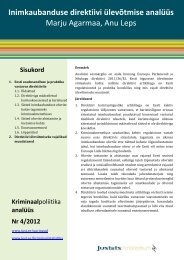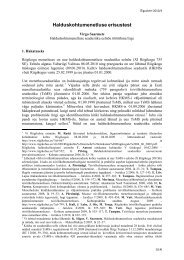11. Retsidiivsus Eestis - Justiitsministeerium
11. Retsidiivsus Eestis - Justiitsministeerium
11. Retsidiivsus Eestis - Justiitsministeerium
You also want an ePaper? Increase the reach of your titles
YUMPU automatically turns print PDFs into web optimized ePapers that Google loves.
RETSIDIIVSUS EESTIS 2010<br />
RETSIDIIVSUS EESTIS 2010<br />
tors also refer to the fact that in case of people who have used violence, the<br />
possibility to commit new criminal offense is not substantially lower than,<br />
for example, in case of people who have committed criminal offences against<br />
property.<br />
In case of crimes of violence, in the group of people released from prison<br />
also this was studied how the recidivism of people punished for manslaughter<br />
differed from the level of committing new criminal offences by people punished<br />
for other (less serious) crimes of violence. It became evident that the probability<br />
that a person who has been punished for manslaughter and is released<br />
from prison will commit within six months some new criminal offence is on<br />
the average three times smaller than in case of people who have committed<br />
other crimes of violence. This proportion does not considerably change when<br />
we compare criminal offences committed within four years after release: from<br />
the killers who were released in 2004 31% had committed a new criminal<br />
offence within four years, however, by 65% of people who had committed<br />
other crimes of violence. While comparing these two indicators it is evidently<br />
more relevant to point out the differences related to manslaughter which are,<br />
for example, that a large number of manslaughters are committed impulsively<br />
between people close to each other, people committing manslaughter have<br />
often not been previously punished and often there are no other factors referring<br />
to heightened recidivism risk.<br />
Figure 6. The one-year recidivism rate for people released from prison in corresponding<br />
year<br />
Low recidivism rate in case of manslaughters shows that in most cases we are<br />
not dealing with people who are dangerous for the society. At the same time,<br />
while they are still people who have committed the most serious criminal<br />
offence, we cannot reproach the bodies conducting proceedings for the fact<br />
which was confirmed in this analysis that upon premature release of killers the<br />
recidivism risk is considered more thoroughly than in case of people who have<br />
committed other criminal offences.<br />
2. RECIDIVISM OF PEOPLE WITH RESPECT TO<br />
WHOM PROCEEDINGS WERE TERMINATED FOR<br />
REASONS OF EXPEDIENCY<br />
JAKO SALLA<br />
The principle of legality in criminal proceedings means this that the court<br />
has to decide on the guilt of all people suspected of criminal offences, thus all<br />
criminal matters should reach the court. However, a possibility has been introduced<br />
to modern criminal proceedings not to decide on the matter of guilt<br />
and terminate proceedings due to reasons of expediency (under the so-called<br />
principle of opportunity). On one hand this saves time and money in criminal<br />
proceedings, on the other hand, it will provide a possibility to spare people<br />
who have committed less serious criminal offences from judicial proceedings<br />
and the negative stigma associated with criminal punishment.<br />
The effective Code of Criminal Procedure (CCP) prescribes the bases of<br />
termination due to reasons of expediency in §§ 201-205. Among those the<br />
most common bases for termination is termination of criminal proceedings<br />
due to lack of public interest (Code of Criminal Procedure, § 202).<br />
This analysis shows what is the recidivism of those people with respect<br />
to whom proceedings have been terminated termination due to reasons of<br />
expediency. Presumably, the recidivism rate of these people should be lower<br />
compared to the people who have reached the court. First, the termination due<br />
to lack of public interest is used with respect to people who have committed<br />
less serious criminal offences for the first time. The bases prescribed in § 201<br />
of the Code of Criminal Procedure with which a minor who has committed<br />
the act is referred to juvenile committee is used just like the name says in<br />
case of minors who have not been able due to their young age to repeatedly<br />
commit criminal offences and whose criminal offences are of less serious<br />
nature. Probably these people are somewhat more recidivistic with respect to<br />
whom proceedings have been terminated due to lack of proportionality of<br />
punishment (Code of Criminal Procedure, § 203), as in their case proceedings<br />
are terminated namely because of the reason that the person has committed<br />
also other criminal offence, i.e. it may be assumed that the act committed by<br />
the person was not accidental. Main purpose of using this basis for termination<br />
is to save procedural resources.<br />
2.1. Database<br />
The sample of terminated proceedings was made up from proceedings which<br />
have been terminated by a prosecutor. The court can also terminate proceed-<br />
170<br />
171

















